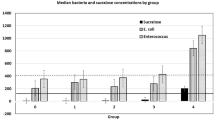Abstract
Antibiotic resistance analysis was performed on fecal coliform(FC) bacteria from a mixed-use watershed to determine thesource, human or nonhuman, of fecal coliform contamination. The study consisted of discriminant analysis of antibioticresistance patterns generated by exposure to fourconcentrations of six antibiotics (ampicillin, gentamicinsulfate, kanamycin, spectinomycin dihydrochloride,streptomycin sulfate, and tetracycline hydrochloride). Areference database was constructed from 1125 fecal coliformisolates from the following sources: humans, domestic animals(cats and dogs), agricultural animals (chickens, cattle, andhorses), and wild animals. Based on similar antibioticresistance patterns, cat and dog isolates were grouped asdomestic animals and horse and cattle isolates were grouped aslivestock. The resulting average rate of correctclassification (ARCC) for human and nonhuman isolates was94%. A total of 800 FC isolates taken from the watershedduring either a dry event or a wet event were classifiedaccording to source. Human sources contribute a majority(>50%) of the baseflow FC isolates found in the watershed inurbanized areas. Chicken and livestock sources areresponsible for the majority of the baseflow FC isolates foundin the rural reaches of the watershed. Stormwater introducesFC isolates from domestic (∼16%) and wild (∼21%) sourcesthroughout the watershed and varying amounts (up to 60%) fromchicken and livestock sources. These results suggest thatantibiotic resistance patterns of FC may be used to determinesources of fecal contamination and aid in the direction ofwater quality improvement.
Similar content being viewed by others

References
American Public Health Association: 1992, Standard Methods for the Examination of Water and Wastewater, 18th ed., American Public Health Association, Inc., Washington, D.C.
Berg, D. E., Akopyants, N. S. and Kersulyte, D.: 1994, 'Fingerprinting microbial genomes using the RAPD or AP-PCR method', Meth. Mol. Cell. Biol. 5, 13-24.
Bernhard, A. E. and Field, K. G.: 2000, 'Identification of nonpoint sources of fecal pollution in coastal waters by using host-specific 16S ribosomal DNA genetic markers from fecal anaerobes', Appl. Environ. Microbiol. 66, 1587-1594.
Devriese, L. A., Pot, B. and Collins, M. D.: 1993, 'Phenotypic identification of the genus Enterococcus and differentiation of phylogenetically distinct enterococcal species and species groups', J. Appl. Bacteriol. 75, 399-408.
Environmental Protection Agency. 1 September: 1999, NationalWatershed Database 305b. [Online]. http://www.epa.gov/surf3/states/VA (20 June 2000, last date accessed).
Feachem, R.: 1975, 'An improved role for faecal coliform to faecal streptococci ratios in the differentiation between human and nonhuman pollution sources', Water Res. 9, 689-690.
Hagedorn, C., Robinson, S. L. Filtz, J. R. Grubbs, S. M. Angier, T. A. and Reneau Jr., R. B.: 1999, 'Determining sources of fecal pollution in a rural Virginia watershed with antibiotic resistance patterns in fecal streptococci', Appl. Environ. Microbiol. 65, 5522-5531.
Holmberg, S. D., Osterholm, M. T., Senger, K. A. and Cohen, M. L.: 1984, 'Drug-resistant salmonella from animals fed antimicrobials', N. Engl. J. Med. 311, 617-622.
Krumperman, P. H.: 1983, 'Multiple antibiotic resistance indexing of Escherichia coli to identify high-risk sources of fecal contamination of foods', Appl. Environ. Microbiol. 46, 165-170.
Rusin, P. A., Sinclair, N. A., Gerba, C. B. and Gershman, M: 1992, 'Application of phage typing to the identification of sources of groundwater contamination', J. Contam. Hydrol. 11, 173-188.
Simmons Jr., G. M.: 1994, 'Potential Sources for Fecal Coliforms in Tidal Inlets', Proceedings of the Interstate Seafood Seminar, pp. 49?67.
Sinton, L. W., Donnison, A. M. and Hastie, C. M.: 1993, 'Faecal streptococci as faecal pollution indicators: A review. II. Sanitary significance, survival, and use', N. Z. J. Mar. Freshw. Res. 27, 117-137.
Wiggins, B. A.: 1996, 'Discriminant analysis of antibiotic resistance patterns in fecal streptococci, a method to differentiate human and animal sources of fecal pollution in natural waters', Appl. Environ. Microbiol. 62, 3997-4002.
Wiggins, B. A., Andrews, R. W., Conway, R. A., Corr, C. L., Dobratz, E. J., Dougherty, D. P., Eppard, J. R., Knupp, S. R., Limjoco, M. C., Mettenburg, J. M., Rinehardt, J. M., Sonsino, J., Torrijos, R. L. and Zimmerman, M. E.: 1999, 'Use of antibiotic resistance analysis to identify nonpoint sources of fecal pollution', Appl. Environ. Microbiol. 65, 3483-3486.
Author information
Authors and Affiliations
Rights and permissions
About this article
Cite this article
Burnes, B.S. Antibiotic Resistance Analysis of Fecal Coliforms to Determine Fecal Pollution Sources in a Mixed-Use Watershed. Environ Monit Assess 85, 87–98 (2003). https://doi.org/10.1023/A:1023357200980
Issue Date:
DOI: https://doi.org/10.1023/A:1023357200980



